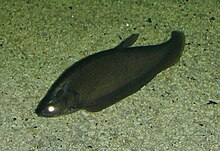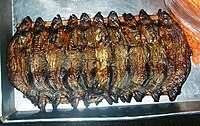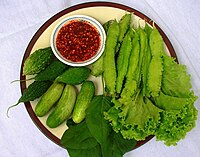| Bronze featherback | |
|---|---|

| |
| Conservation status | |
 Least Concern (IUCN 3.1) | |
| Scientific classification | |
| Domain: | Eukaryota |
| Kingdom: | Animalia |
| Phylum: | Chordata |
| Class: | Actinopterygii |
| Order: | Osteoglossiformes |
| Family: | Notopteridae |
| Genus: | Notopterus Lacépède, 1800 |
| Species: | N. notopterus |
| Binomial name | |
| Notopterus notopterus (Pallas, 1769) | |

| |
| Red:extant , Green: introduced | |
| Synonyms | |
| |
The bronze featherback (Notopterus notopterus) is a ray-finned fish in the family Notopteridae found in South and Southeast Asia. Although primarily found in fresh water, it has been known to enter brackish water. At present, it is the only member of the genus Notopterus, but as currently defined, it is likely a species complex.
Description

Young specimens are a dark bronze-like color that becomes lighter with age. The species reaches a length up to 60 cm (24 in).
The bronze featherback can easily be kept in an aquarium. Popular as food, this fish also appears in a stamp of the Kingdom of Laos.
As food
This fish has been used as food in Southeast Asia since ancient times, and remains an important food item in countries such as Indonesia, Laos, Myanmar (Burma), and Thailand. It is preserved and prepared in different ways.
In Burmese cuisine, the flesh of the bronze featherback, locally known as ngaphe, is used in ngachin, a pressed fish pickle, and is used to make fish paste.
In Thai cuisine, a variety of nam phrik with minced roasted pla salat is eaten along with raw vegetables. It is popular in Khorat. Although much smaller in size, it is similar in appearance to the Chitala ornata, another important fish in Thai cuisine.
 |
 |
See also
References
- ^ Ng, H.H. (2020). "Notopterus notopterus". IUCN Red List of Threatened Species. 2020: e.T166433A60584003. doi:10.2305/IUCN.UK.2020-1.RLTS.T166433A60584003.en. Retrieved 3 May 2022.
- ^ Froese, Rainer; Pauly, Daniel (eds.). "Notopterus notopterus". FishBase. February 2022 version.
- Froese, Rainer; Pauly, Daniel (eds.). "Species in genus Notopterus". FishBase. February 2022 version.
- WoRMS - Notopterus notopterus
- Charles Higham, A. Kijnga ed. The Origins of the Civilization of Angkor: Volume VI The Iron Age. page 43. IV 'The Fish Remains'
- "ပဲခူးငါးချဉ်စျေးကွက် ဆက်လက်ဖွံ့ဖြိုးနေ". Department of Consumer Affairs (in Burmese). Retrieved 2021-12-30.
- Nam phrik pla salat pon recipe
External links
| Osteoglossomorpha | |||||||||||||||||||||
|---|---|---|---|---|---|---|---|---|---|---|---|---|---|---|---|---|---|---|---|---|---|
| |||||||||||||||||||||
| Taxon identifiers | |
|---|---|
| Notopterus notopterus | |
This Osteoglossiformes-related article is a stub. You can help Misplaced Pages by expanding it. |


